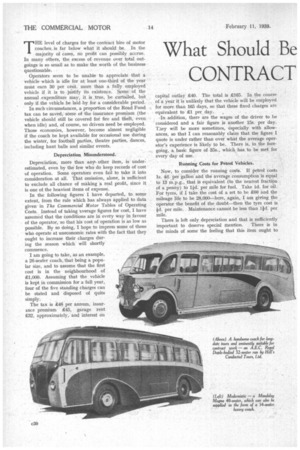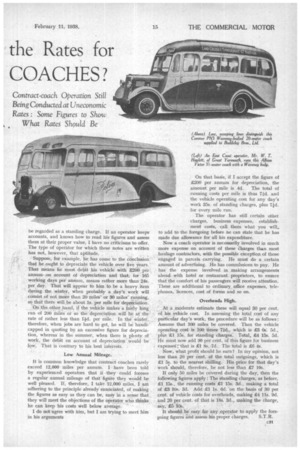What Should Be the Rates for CONTRACT COACHES?
Page 80

Page 81

If you've noticed an error in this article please click here to report it so we can fix it.
THE level of charges for the contract hire of motor coaches, is far below what it should .be. In the majority of cases, no profit can possibly accrue. In many others, the excess of revenue over total outgoings is so small as to make the worth of the business questionable.
Operators seem to be unable to appreciate that a vehicle which is idle for at least one-third of the year must earn 30 per cent, more than a fully employed vehicle if it is to -jiiitify its existence. SQUCle of the annual expenditure may, it is true, be curtailed, but only if the vehicle be laid -by for a considerable period.
In such-circumstances, a proportion of the Road Fund tax can be saved, some of the insurance premium (the vehicle should still be covered for fire and theft, even when idle) and, of course, no drivers need be employed. Those economies, however, become almost negligible if the coach be kept available for occasional use during the winter, for football parties, theatre parties, dances, including hunt balls and similar events.
Depreciation Misunderstood.
Depreciation, more than any other item, is underestimated, even by the few who do keep records of cost of operation. Some operators even fail to take it into consideration at all. That omission, alone, is sufficient to exclude all chance of making a real profit, since it is one of the heaviest items of expense.
In the following figures I have departed, to some extent, from the rule which has always applied to data given in The Commercial Motor Tables of Operating Costs. Instead of taking average figures for cost, I have assumed that the Conditions are in every way in favour of the operator,' so that his cost of operation is as low as possible. By so doing, I hope to impress some of those who operate at uneconomic rates with the fact that they ought to increase their charges during the season which will shortly commence.
I am going to take, as an example, a 26-seater coach, that being a popular size, and to assume that the first cost is in the neighbourhood of £1,000. Assuming that the vehicle is kept in commission for a full year, four of the five standing charges can be stated and disposed of quite simply.
The tax is £48 per annum, insurance premium 245, garage rent £32, approximately, and interest on capital outlay £40. The total is £165. In the course of a year it is unlikely that the vehicle will be employed for more than 165 days, so that these fixed charges are equivalent to 21 per day. ,
-In addition, there are the wages of the driver to be considered and a fair figure is another 15s. per day. They will be more sometimes, especially with allowances, so that I can reasonably claim that the figure I quote is under rather than over what the average operator's experience is likely to be. There is, in the foregoing, a basic figure of 35s., which. has to be met for every day of use.
Running Costs for Petrol Vehicles.
Now, to consider the running costs. If petrol costs Is 4d per gallon and the average consumptionis equal to 13 m.p.g., that is equivalent (to the nearest fraction.. of a penny) to lid. per mile for fuel. Take id. for oil. For tyres, if I take the cost of a set to be £60 and the mileage life to be 28,000—here, again,. I am giving the operator the benefit of the doubt—then the tyre cost is id. per mile. Maintenance cannot be less than lid. per mile.
There is left only, depreciation and that is sufficiently important to deserve special mention. There is in the minds of some the feeling that this item ought to
be regarded as a standing charge. If an operator keeps accounts, and knows how to read his figures and assess them at their proper value, I have no criticisms to offer. The type of operator for which these notes are written has not, however, that aptitude.
Suppose, for example. he has come to the ccinclusion that he ought to depreciate the vehicle over five years. That means he must debit his vehicle with 2200 per annum on account of depreciation and that for 165 . working days per annum, means rather more than 24s. per day. That will appear to him to be a heavy item during the winter, when probably a day's work will consist of not more than 20 miles' or 30 miles' running, so that there will be about 1s. per mile for depreciation.
On the other hand, if the vehicle makes a fairly long run of 200 miles or so the depreciation will be at the rate of rather less than lid. per mile. In the winter. therefore, when jobs are hard to get, he will be handicapped in quoting by an excessive figure for depreciation, whereas in the summer, when there is plenty of work, the debit on account of depreciation would be low. That is contrary to his best interests.
Low Annual Mileage.
ft is common knowledge that contract coaches rarely exceed 12,000 miles per annum. I have been told by experienced operators that if they could foresee a regular annual mileage of that --figure they would be well pleased. If, therefore, I take 12,000 miles, I am adhering to the principle already enunciated, of making the figures as easy as they can be, easy in a sense that they will meet the objections of the operator who thinks he can keep his costs Well below average.
I do not agree with him, but I am trying to meet him in his arguments On that basis, if I accept the figure of £200 per annum for depreciation, the amount per mile is 44. The total of running costs per mile is thus 7/d. and the vehicle operating cast for any day's work 35s. of standing charges, plus 7id. for every mile run.
The operator has still certain other charges, business expenses, establishment costs, call them what you will,. to add to the foregoing before he can state that he has made due allowance for all his expenditure.
Now a coach operator is necessarily involved in much more expense on account of these charges than most haulage contractors, with the possible exception of those engaged in parcels carrying. He must do a certain amount of advertising. He has commissions to pay. He has the expense involved in making arrangements ahead with hotel or restaurant . proprietors, to ensure that the comfort of his passengers will receive attention. These are additional to ordinary. office expenses, telephones, licences, cost of forms and so on.
Overheads High.
At a moderate estimate these will equal 30 per cent. of his vehicle cost. In assessing the total cost of any particular day's work, the procedure will be as follows: Assume that 100 milts be covered. Then the vehicle operating cost is 100 times 7/d., which is £3 Os. 5d., plus £1 15s. for standing charges. Total, £4 15s. 5d. He must now add 30 per cent, of this figure for business expenseS',-that is £1 8s. 7d. The total is £6 4s.
Now, what profit should he earn? In my opinion, not less than 20 per cent. of the total outgoings, which is £1 5s. to the nearest shilling. His price for that day's work. should, therefore, be not less than £7 10s.
If only 50 miles be covered during the day, then the following figures apply : The standing charges, as before, £1. 15s., the running costs £1 15s. 3d., making a total of E.3 10s. 3d. Add 21 is. fid. on the basis of 30 per cent. of vehicle costs for overheads, making £4 11s. 94. and 20 per cent. of that is 18s. 3d., making the charge, say, £5 10s.
It should, be easy for any ,operator to apply the fore going figures and assess his proper charges. S.T.R.




























































































































































